Norway Hall
Norway Hall was located at 2902 Chicago Ave. So. in Minneapolis.
THE BUILDING
Norway Hall was built in 1923 as “brick lodge rooms,” according to the city’s permit card. The cost on the permit was listed as $41,000; in the newspaper announcement it was $55,000. Funds for its erection were provided by the Oslo Lodge of the Sons of Norway, the Alfheim Lodge of the Daughters of Norway, and the Sigyn Lodge of the Daughters of Norway.
The building was designed by architects Long & Thorshov, and built by Andrus construction. The fact that we cannot find a photo of this building makes one wonder if it may not be one of the most inconspicuous buildings in Minneapolis…
The two-story red brick structure had stone trim and a red tile roof. The frontage on Chicago Ave. was 68 feet, and had a depth of 110 feet. “The exterior and interior have been designed in a Norse feeling.” Clubrooms were on the ground floor at the front. Offices were on the second floor. Two lodge rooms, each two stories high, were located in the back of the building. The two rooms could be divided by folding doors or turned into an auditorium that could seat 600 people. A dining room, smoking room, and other facilities were planned for the basement. (Minneapolis Tribune, October 7, 1923)
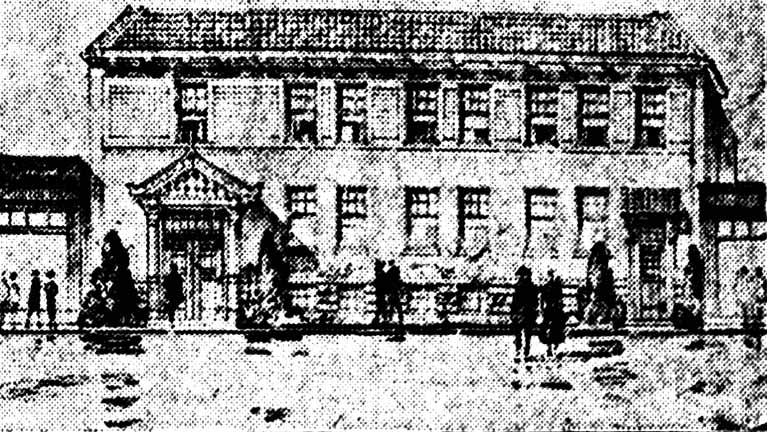
Sketch of the impending Norway Hall, Minneapolis Tribune, October 7, 1923
TWO DIFFERENT WORLDS
Researching the entertainment activities inside Norway Hall is reliant on which newspapers one reads. The resources I used were:
- The Minneapolis Star and Tribune were the mainstream papers of the time, with the Tribune being circulated in the morning and evening, and the Star in the evening only. Both papers were owned by the same company. These papers are available in a searchable database online for a subscription fee.
- The Minneapolis Spokesman has been the primary newspaper for the black community since it was started in 1934 by editor Cecil E. Newman. It was a weekly paper. It carried national as well as local news concerning the black community. Back copies of this paper are now online, thanks to the efforts of the Hennepin County Library and the Library of Congress. This is a free resource. My thanks to James Orndorf for his reminder of this fact!
THE SCANDINAVIAN COMMUNITY
Events catering to the primarily Scandinavian community can be found in the Minneapolis Star and Tribune. The first ad for an event at the new hall was on April 30, 1924. This was a recital by a soprano accompanied by a violinist. From then on it was a busy place, offering concerts, plays, a meeting place, and other functions of a large hall.
The ad below for a New Year’s Eve dance featuring Slim Jim (Iverson) would have been popular with the Norwegians in Minneapolis, if you could get them to attend such a scandalous affair!
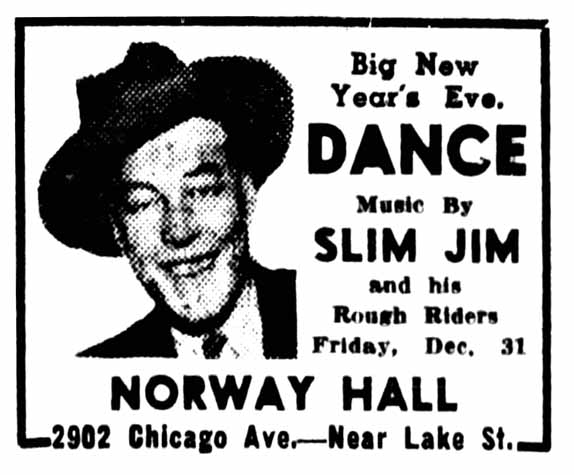
Minneapolis Tribune, December 31, 1937
1940
Regular dances started up in 1940. The ad below is billed as a Grand Opening Dance, but may just be for the season. It was in September, and the hall may have been closed in the summer because of the heat. Ted Johnson was a frequent purveyor of the music at Norway Hall.
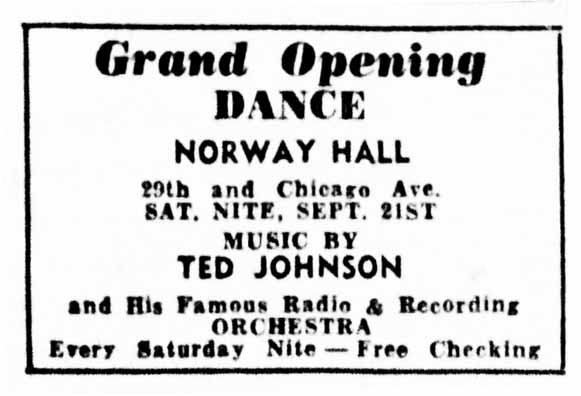
Minneapolis Tribune, September 20, 1940
1945
Dances generally stopped during the War years of 1943 – 1944. They started up again with regularity in March 1945. The ad below says that Ollei Skratthult will sing some of his best songs. Now that’s a good Scandinavian name!
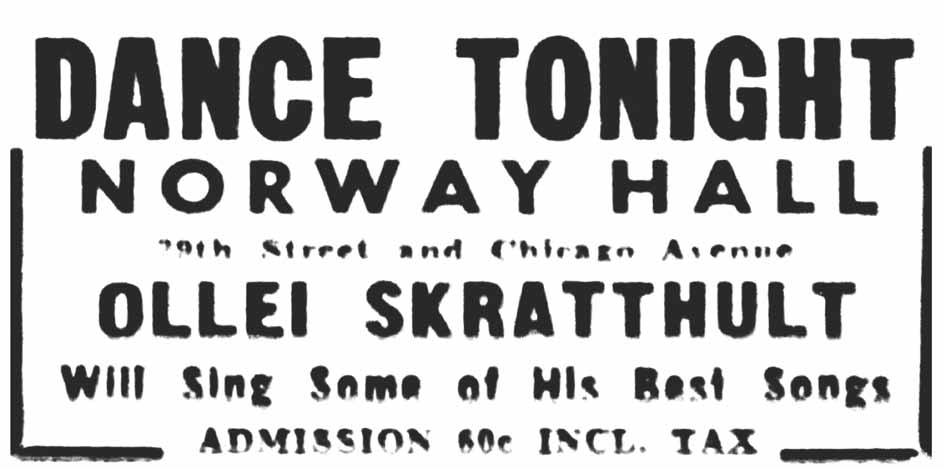
Minneapolis Tribune, March 10, 1945
1946
Ted Johnson was back for the 1946/1947 season.
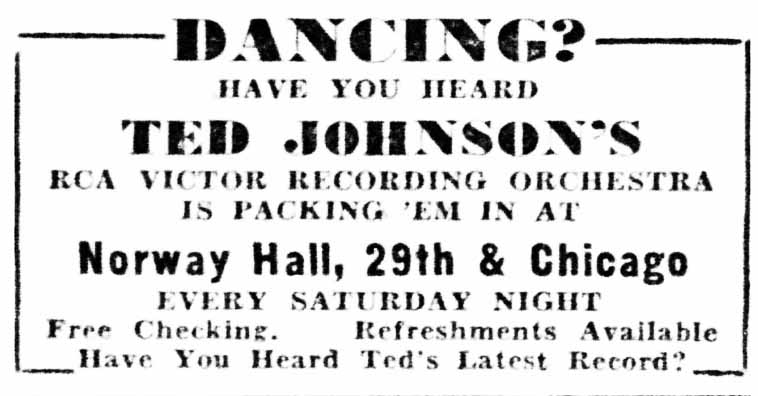
Minneapolis Star, January 3, 1947
1949
In September 1949 we see the advent of Thorstein Skarning, a character who someone should write a book about. But competition between ballrooms was tough, and he was soon replaced by the Scandia Rhythm Orchestra the next month. Skarning would be back later in 1950.
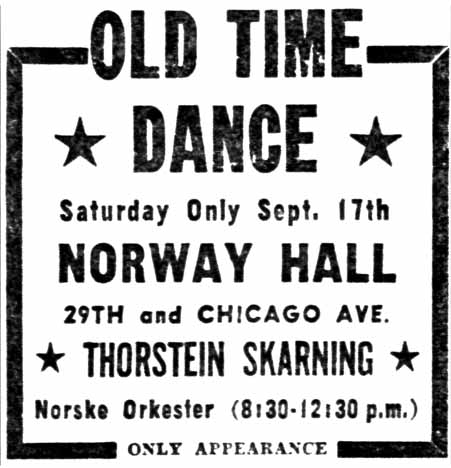
Minneapolis Star, September 13, 1949
No ads for dances from 1951 until last one on February 1956?
THE BLACK COMMUNITY
The Minneapolis Spokesman contained many ads for dances and shows at Norway Hall. Ads go back to at least 1935, and these events may have been going on even further back. None of these events are advertised in the Minneapolis Star or Tribune. I’ll start the chronology over with these ads.
1935
The first ad I found was a dance given by the Credjafawn Club. Most of the dances were sponsored by private clubs. The Credjafawn Club got its name by combining the letters of the names of the women in the club. Entertainment was provided by Eli Rice and his Dixie Cotton Pickers, a very popular group at the time.
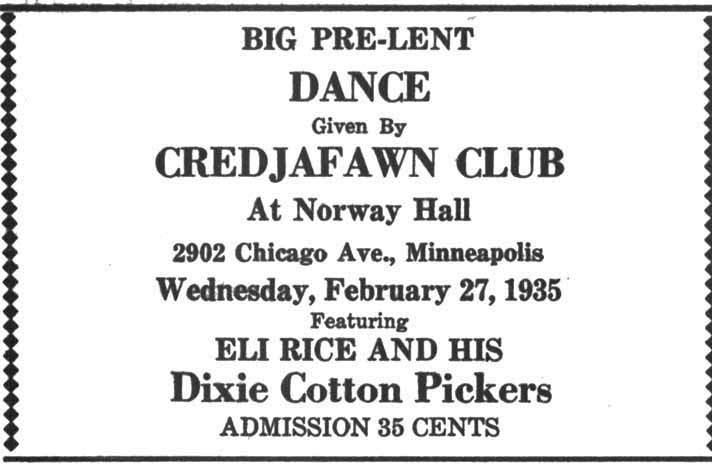
Minneapolis Spokesman
1936
The ad below is for a Style Show and Dance. Seems like women would be more interested in a style show, but they must have taken their husbands along to dance with afterwards.
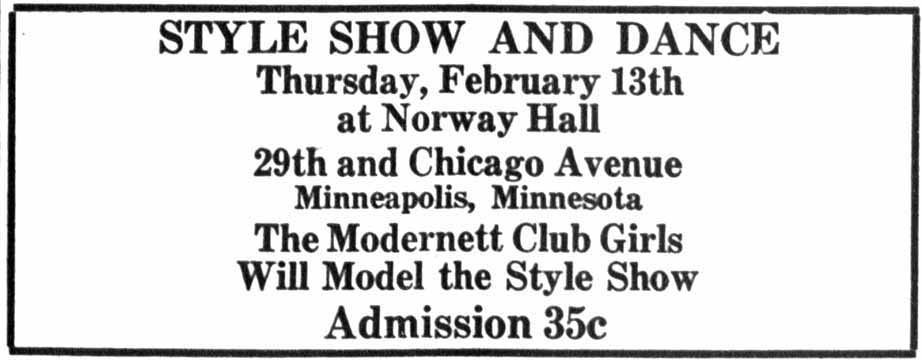
Minneapolis Spokesman, 1936
The Minnesota-Iowa Club gave a Cabaret Dance Party on May 11, 1936, with the theme “A Night in Spain.” Roy Dysart’s Band played for dancing, and a floor show was promised!
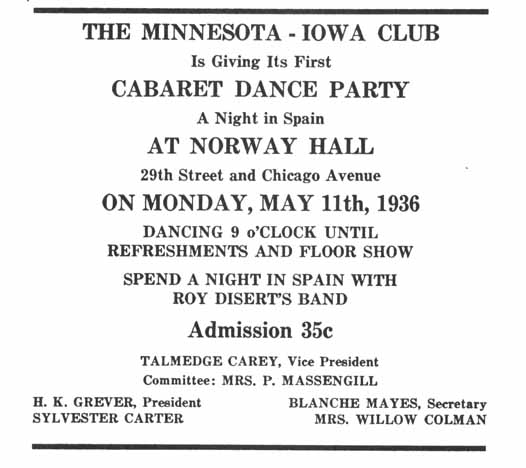
Minneapolis Spokesman, May 1, 1936
A Gigantic Labor Day Dance was sponsored by the Gloom Chasers Club on September 7, 1936. Ray Dysart’s Band again provided the music.
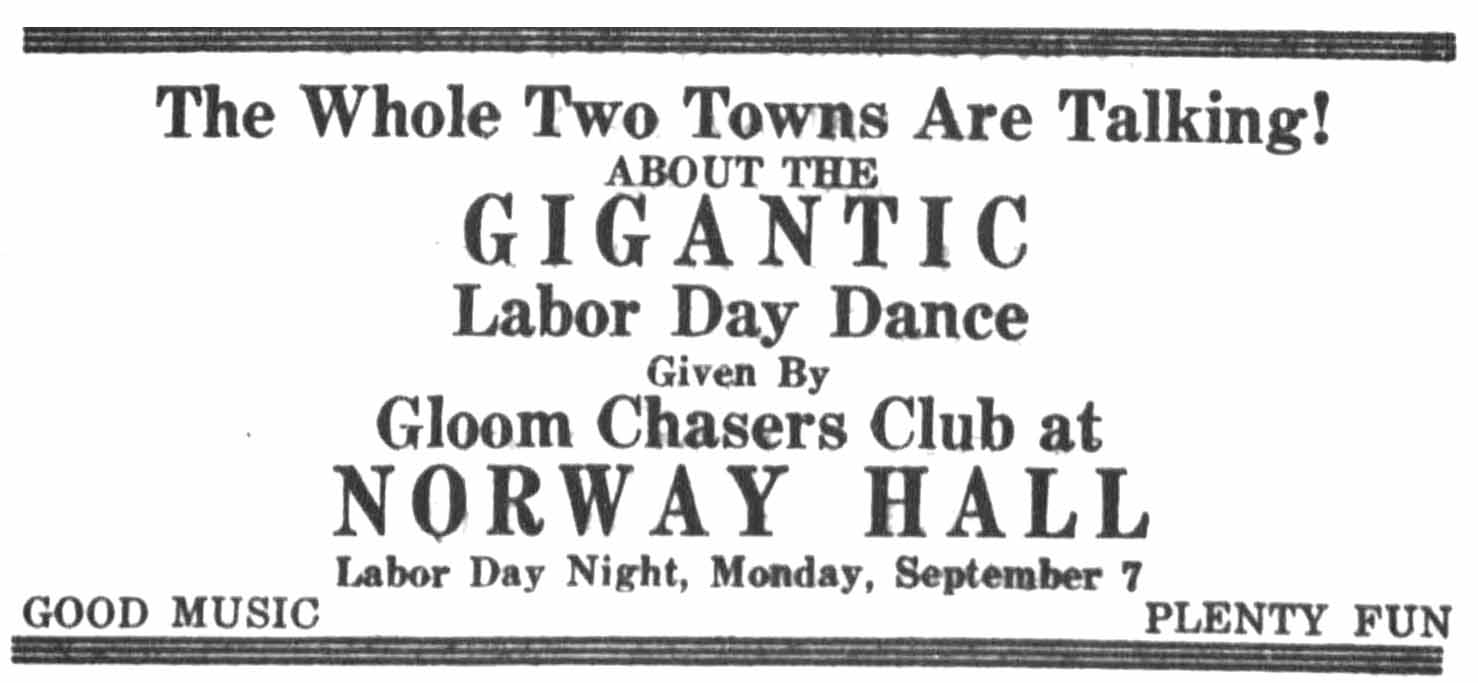
Minneapolis Spokesman, 1936
The Spokesman gave much publicity to the appearance of Nat Towles and His 14 Southern Gentlemen, who performed on September 29, 1936.
In its article about the Towles show, it said:
Norway Hall.. is one of the nicest halls in Minneapolis. It is centrally located, Selby-Lake street cars run within one block of the hall, making it convenient for St. Paul patrons who want to use the street cars. Chicago-Penn and Chicago-Fremont cars run right to the door. (Minneapolis Spokesman, September 25, 1936)
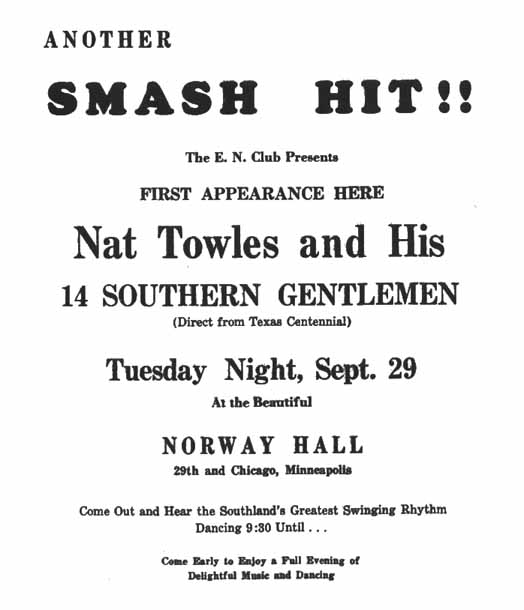
Minneapolis Spokesman, 1936
1937
Jimmie Slemmons presented this next event. Slemmons would later become a three-time “Mayor of Bronzeville” in the ’40s. On May 10, 1937, he presented a fantastic Battle of Music, pitting Boyd Atkins and his famous Cotton Club Orchestra (this was the St. Louis Park Cotton Club) against Gordon Parks’ Chicago Savoy Orchestra. It was billed as the Battle of the Century, and it probably was! Proceeds of the dance went to a fund for “a picnic for the children of unemployed colored families with the assistance of business firms in the city.” (Minneapolis Spokesman, April 30, 1937)
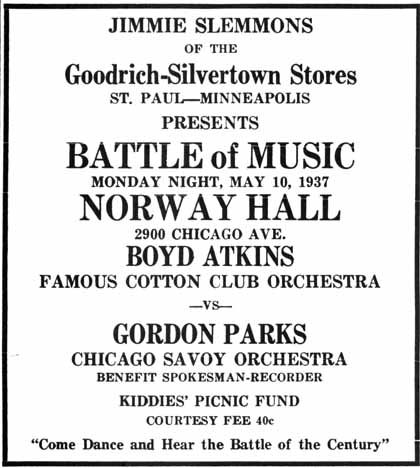
Minneapolis Spokesman
This one’s so good, let’s have two ads:
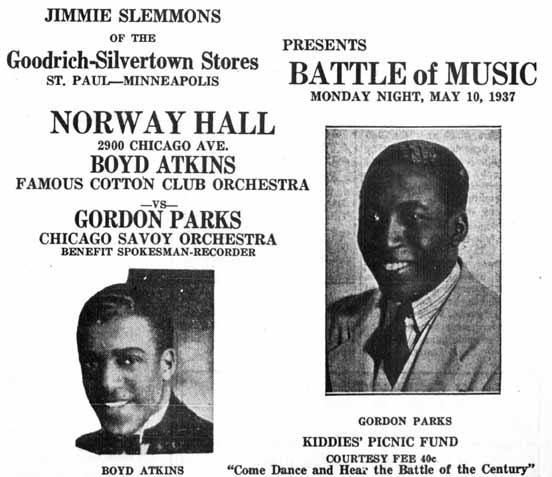
Minneapolis Spokesman
1938
On Valentine’s Day, 1938, a Gala Dance was given by the Twin City Division of the Brotherhood of Sleeping Car Porters, with music by Rook Ganz and His Band.
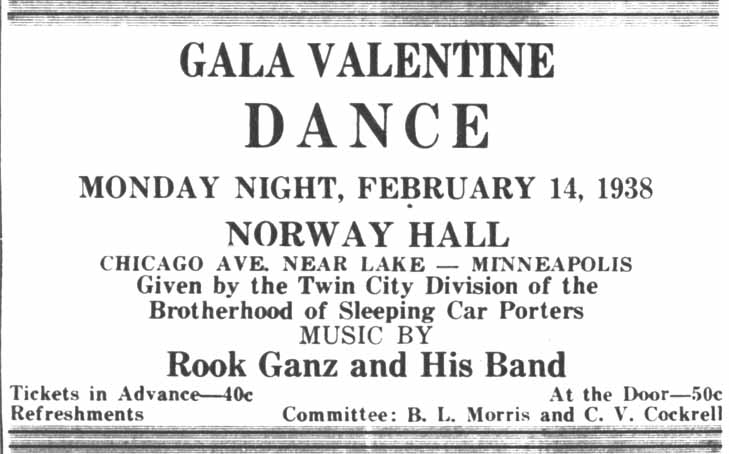
Minneapolis Spokesman
1939
1939 brought Doc Payne, King of the Sax, and His Recording Orchestra to Norway Hall on May 22. The band, direct from the Rex Rose Room in St. Louis, featured “Bubber” Kitson at the piano. A floor show was also on the ticket. (Does a floor show mean showgirls?)
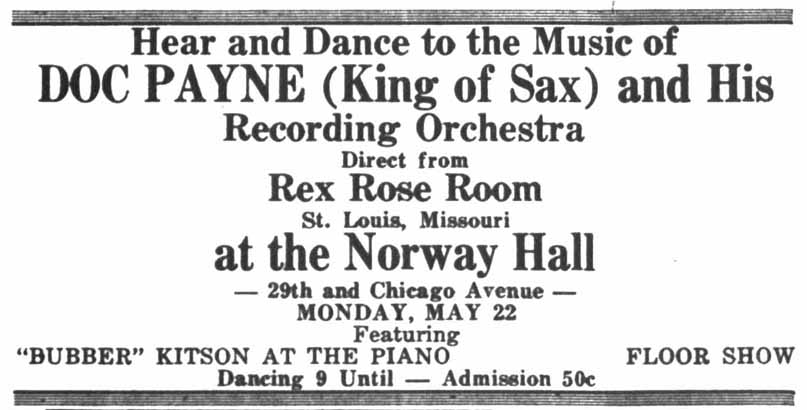
Minneapolis Spokesman, 1939
1945
As above, dances slowed down or stopped during the War. Next one found was when the Ames Lodge No. 106, Improved Benevolent Protective Order of Elks of the World, gave their Elks Grand Ball at Norway Hall on March 2, 1945. Music was provided by Walter Lear’s Gents of Rhythm. Popularity contests were common at these dances and balls – I’d love to know how they were carried out!
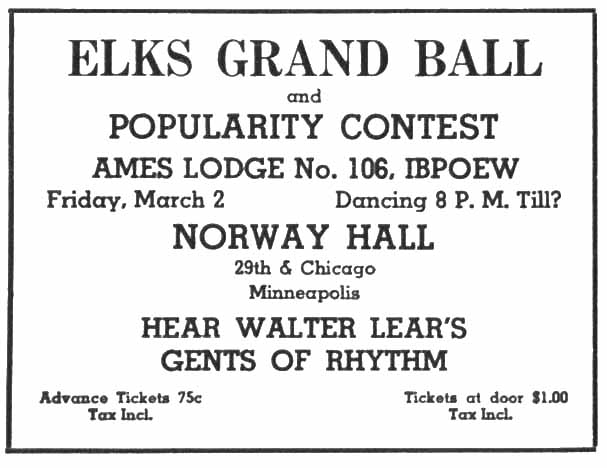
Minneapolis Spokesman, 1945
A Grand Halloween Ball was given by the Ames Lodge 106 and Minnehaha Temple No. 129 of the Improved Benevolent Protective Order of Elks of the World in 1945. Music was provided by Sir Walter Lear and His Rhythmeers.
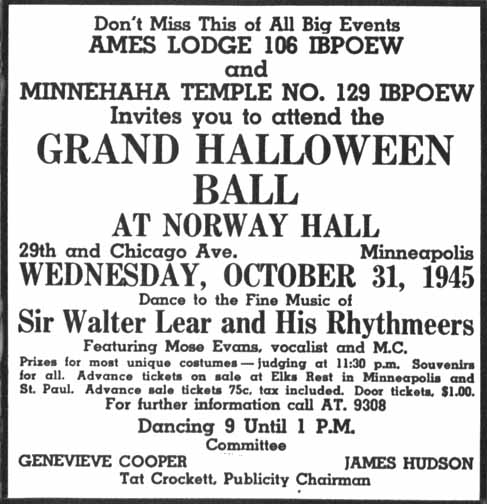
Minneapolis Spokesman
An Armistice Day Frolic was hosted by Johnnie Baker American Legion Post 291 and Women’s Auxiliary on Monday, November 12, 1945. All returning veterans in uniform were admitted for free. Music was provided by Howard Brown and His Rhythm Kings.
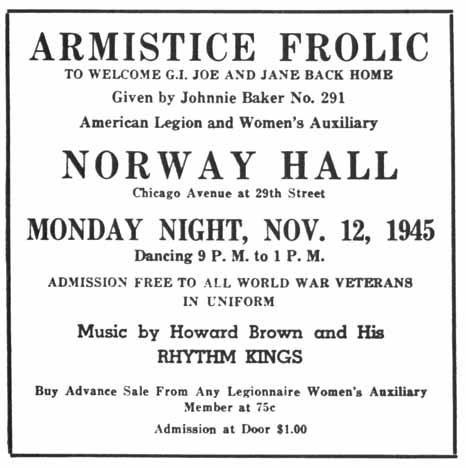
Minneapolis Spokesman
1946
Brutus Cassius sponsored an Armistice Day Dance on November 11, 1946, noted to be “Cabaret Style.” The ad is too blurry to post, but the musicians included:
- Percy Hughes and his Ex-Navy Band
- Judy Perkins, Pleasing Vocalist
- David “Duffy” Goodlow, Dynamic Trumpeter
- Bobby Crittenden, “Mr. Drums”
- Frank Lewis, “Noted Arranger and Tenor Sax”
Brutus Cassius sponsored a Pre-Season Holiday Dance on December 1, 1946, with the same line-up as his Armistice Day Dance of the previous November:
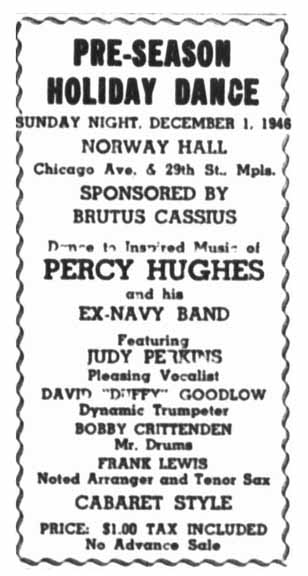
Minneapolis Spokesman
1956
There’s a note that Chuck Berry played at Norway Hall in April 1956. It appears that all regular dances seem to have ended for everyone at Norway Hall in 1956 for some reason.
GOPHER HALL
The next milestone is approximately April 1961, when the building was apparently sold to the Veterans of Foreign Wars Gopher Pup Tent No. 2 and became known as Gopher Hall for the rest of its life.
There are very few indications of public events, other than some square dances held by the VFW in March 1967.
NORWAY/GOPHER HALL BURNS DOWN
The building went down in a blaze on January 20, 1992. Unlike the old days of multiple news articles and photos, the papers published one photo with a caption. The building was described as “vacant,” which could mean that nobody was in it at the time, or that it had been abandoned. The fire started in the basement at about 9 pm at took 45 firemen to subdue.
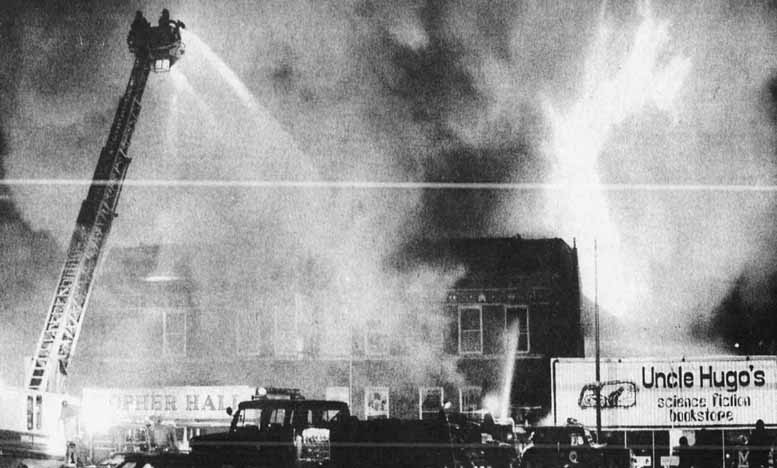
Minneapolis Tribune, January 21, 1992
